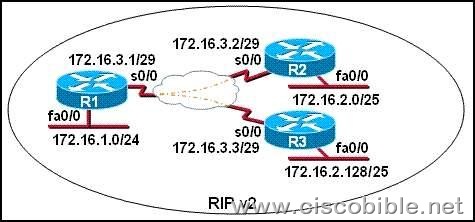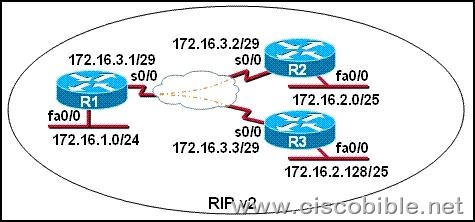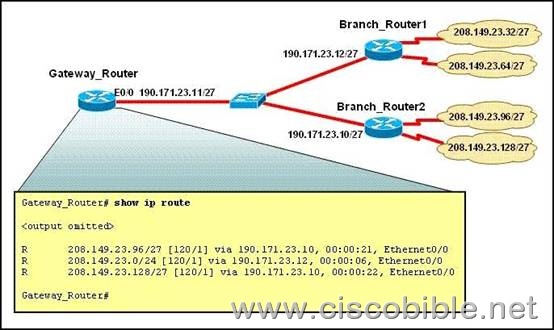|
This page was exported from Free Cisco Training & Resources - Certification Exam Preparation
[ https://www.ciscobibles.com ] Export date: Fri Dec 19 20:50:22 2025 / +0000 GMT |
CCNA 640-802 Bible - Configure,Verify and Troubleshoot RIPv2
A:All routers will reference their topology database to determine if any backup routes to the 192.168.1.0 network are known. B:Routers R2 and R3 mark the route as inaccessible and will not accept any further routing updates from R1 until their hold-down timers expire. C:Because of the split-horizon rule, router R2 will be prevented from sending erroneous information to R1 about connectivity to the 192.168.1.0 network. D:When router R2 learns from R1 that the link to the 192.168.1.0 network has been lost, R2 will respond by sending a route back to R1 with an infinite metric to the 192.168.1.0 network. E:R1 will send LSAs to R2 and R3 informing them of this change, and then all routers will send periodic updates at an increased rate until the network again converges. Correct Answers: C, D Explanation: RIP version 2 will send triggered updates when the topology changes like when a link goes down. The following are the key characteristics of RIPv2 pertaining to this question: 1. Split horizon - RIP doesn't advertise routes back out the interface in which they came. Or put another way, a router won't tell a neighbor about routes that the neighbor presumably already knows about. That would be silly, and could cause a loop in certain circumstances. 2. Triggered update - RIP will send an update out just a soon as the routing table changes. He won't wait for the Update timer to expire. 3. Route poisoning- RIP will tell other routers that a failed route is junk by advertising it with an infinite metric (which is 16 for RIP), effectively poisoning it.
A:It has the same maximum hop count as version 1. B:It uses broadcasts for its routing updates. C:It is a classless routing protocol. D:It has a lower default administrative distance than RIP version 1. E:It supports authentication. F:It does not send the subnet mask in updates. Correct Answers: A, C, E
A: Configure the no ip subnet-zero command on R1, R2, and R3. B: Dynamic routing protocols such as RIP v2 cannot be used across Frame Relay networks. C: Configure the s0/0 interface on R1 as two subinterfaces and configure point-to-point links to R2 and R3. D: Change the 172.16.2.0/25 and 172.16.2.128/25 subnetworks so that at least two bits are borrowed from the last octet. E: Change the network address configurations to eliminate the discontiguous 172.16.2.0/25 and 172.16.2.128/25 subnetworks. Correct Answers: C Explanation: For Dynamic Routing in Hub-and spoke topology, configure the subinterface for each link then define the link as point to point. One reason for the use of subinterfaces is to circumvent the rule of split horizon. Split horizon dictates that a route cannot be advertised out the same interface upon which it was learned in the first place. This can be a problem in hub and spoke frame relay networks, but by using pt-pt subinterfaces this problem will be eliminated.
A: The ip subnet-zero command has been issued on the R1 router. B: The RIP v2 dynamic routing protocol cannot be used across a Frame Relay network. C: Split horizon is preventing R2 from learning about the R3 networks and R3 from learning about the R2 networks. D: The 172.16.2.0/25 and 172.16.2.128/25 networks are overlapping networks that can be seen by R1, but not between R2 and R3. E: The 172.16.3.0/29 network used on the Frame Relay links is creating a discontiguous network between the R2 and R3 router subnetworks. Correct Answers: C Explanation: Under normal circumstances, the router that is connected to the broadcast IP network and uses the distance vector routing protocol will use split horizon mechanism to avoid routing loop. Split horizon is a technology to avoid routing loop and speed up the routing convergence. The router may receive the routing information sent by itself which is useless, split horizon will not advertise the routing update information back received from the terminal , while it will advertise those routes that will not be cleared because of the endless counting .It can be simply interpreted that the route learnt by a router from one interface will not be sent through the same interface . For the non-broadcast network (such as Frame–Relay and High Speed Switched Data Services), the effect of split horizon is not ideal. So, we can use the following commands to disable or enable split horizon. ip split-horizon to enable split horizon no ip split-horizon to disable split horizon
A: Gateway_Router is configured to receive only RIPv1 updates. B: Gateway_Router is configured to only receive RIPv2 updates. C: Branch_Router2 is configured to send both RIPv1 and RIPv2 updates. D: Branch_Router1 is configured to only send RIPv1 updates. Correct Answers: D Explanation: The default version of RIP is version 1, which doesn't supports multicast updates, classless networks, and authentication. It appears that Router1 is configured with RIP v1 so it's sending only v1 packets, which means only the classful network of 208.149.23.0/24 is being advertised. However, it appears that Router2 is indeed using RIPv2 as both the /27 networks are being advertised from that router. If you wish to enable to RIP version 2 on router use following command: Router(Config)#router rip Router(Config-router)#version 2 |
|
Post date: 2009-07-20 15:33:35 Post date GMT: 2009-07-20 07:33:35 Post modified date: 2010-07-22 23:09:33 Post modified date GMT: 2010-07-22 15:09:33 |
| Powered by [ Universal Post Manager ] plugin. HTML saving format developed by gVectors Team www.gVectors.com |



